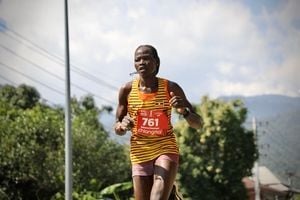Why Burundi has the highest malaria transmission in EA

Homes on the shores of a swollen Lake Tanganyika in Bujumbura, Burundi.
What you need to know:
- While other African countries have brought their transmission rates down in the last 20 years, in Burundi, cases of infection have been going in the opposite direction, rising more than twofold two years ago, the Malaria Journal observes.
- Like elsewhere in the region, expectant mothers and children aged below five years are the most vulnerable demographic to malaria.
Spectacular geography of mountains, water bodies, farmlands and cultural diversity make Burundi arguably one of the most stunning countries in East and Central Africa.
Yet nowhere is this splendour more pronounced than in the capital, Bujumbura. The city hugs Lake Tanganyika on the eastern side and sits on the floor of a series of fringe hills, spreading to the border with Democratic Republic of Congo.
Beneath this beauty, though, lies a dark and dreadful reality, thanks to a high malaria infection rate in the country. The United States Agency for International Development puts Malaria as the leading cause of morbidity and mortality in Burundi. Outbreaks are so common.
In 2019, for instance, a malaria epidemic swept through the nation, with more than seven million cases and nearly 3,000 fatalities reported.
While other African countries have brought their transmission rates down in the last 20 years, in Burundi, cases of infection have been going in the opposite direction, rising more than twofold two years ago, the Malaria Journal observes.
Like elsewhere in the region, expectant mothers and children aged below five years are the most vulnerable demographic to malaria. Adults too are at risk. Ms Aisha Musa, a jeweller in Bujumbura, has had the disease about four times as an adult. ‘‘Out of these, I was hospitalised two times,’’ recounts the 30-year-old.
Ms Diana Ndayisenga, a hotel attendant in the city, has been sick with malaria twice as an adult.
While the disease is dreaded among the people here, it’s not uncommon. “You always know someone whose child or spouse is in hospital with malaria. There are a lot of mosquitoes in Bujumbura,” Ms Ndayisenga tells Healthy Nation.
In Burundi, 48 per cent of all deaths among children under five are from malaria. Data from Burundi’s National Malaria Control Programme shows that 43 per cent of all outpatient hospital visits are malaria-related –even higher among children, at 64 per cent.
But what makes Burundi so vulnerable to malaria?
At 27834 km², Burundi is roughly the size of Mandera County. Though small in landmass, the combination of geography, topography, environmental and human factors in this country makes its population vulnerable to malaria.
High cross-border population movement between Burundi, Uganda, Rwanda and DRC is the biggest headache for authorities in these countries in the fight against malaria. Borders between Burundi, Rwanda, Uganda and DRC are some of the most porous in Africa.
Mr Guy Mnezero, a driver, is a victim of this cross-border transmission. He shared his experience with Healthy Nation. “There’s a lot of malaria in DRC and Rwanda. In 2019, I had travelled to Rwanda for work for two weeks. I got a severe bout while there. I couldn’t come back home. I had to be hospitalised there.’’
To fight malaria jointly with her regional neighbours, Burundi is a member of the Great Lakes Malaria Initiative (GLMI) together with Uganda, Tanzania, Rwanda, Kenya, South Sudan, Zanzibar and the Democratic Republic of Congo.
This ongoing programme (2021-2025) seeks to pool efforts by regional health ministries’ malaria programmes to eliminate cross-border transmissions.
According to GLMI, other key malaria transmission risk factors in the region are climate change, water bodies and insecticide resistance.
Burundi’s location on the edge of the Tropical Rainforest zone, featuring hot and humid conditions, allows for the breeding and spread of Plasmodium falciparum, the parasitic protozoan that causes malaria in humans.
In Bujumbura, for instance, daily temperature averages 28° Celsius throughout the year, reaching highs of 31° Celsius in the month of September. This is seven units hotter than Nairobi, whose hottest months (24° Celsius) are from January through March.
A population explosion in the last 20 years has also severely strained the country’s capacity to provide adequate healthcare services to its citizens, complicating the fight against malaria.
Data from the World Bank shows that the population of Burundi has nearly doubled in the last two decades, growing from only 6.5 million in 2000 to 11.8 million in 2019.
In most health facilities in Bujumbura, the capital, malaria is one of the leading causes for hospitalisation. For a country with an acute shortage of admission facilities, this puts pressure on beds.
Yet even with hospital bed inadequacy and priority sometimes given to HIV/AIDS patients, admission for malaria isn’t popular, with the population too poor to afford hospital treatment. Consequently, many such as Mr Innocent Mazombo, an immigrant from the neighbouring DRC, opt to manage the disease from home, the risks notwithstanding.
"When my wife or children fall sick, we buy (over-the-counter) antibiotics to manage it. It’s what most families in Burundi do. It’s too expensive to treat malaria in a hospital,” says the taxi driver:
The father of two doesn’t have a health insurance cover. He has never owned one. It’s the case with the majority of Burundians. When illness strikes, this population is forced to spend a fortune on treatment.
One curious observation in the streets of Bujumbura is the number of pharmacies and laboratories. Drugstores here are as many as general merchandise stores.
Dealing with the inability to afford treatment is one of the key focuses of the Great Lakes Malaria Initiative through resource mobilisation, coordination, and partnerships between members. The initiative also hopes to build centres of malaria control to help in surveillance, preparedness and response mechanisms.
In Bujumbura and towns such as Gitega, Umonge and Ngozi, chaotic urban planning compounds the risks. Bujumbura, for instance, is surrounded by and at the foot of steep hills, making flooding a common nuisance, sometimes with devastating consequences.
In villages on the fringes of the city, poverty is rife and living conditions dire. The sprawling villages of Mutakura, Buterere, Kinama and Kamenge are some of the poorest in the city and country.
Less than two kilometres from the CBD in Cibitoke district, shacks dominate the landscape, which puts residents at further risk of contracting the disease.
In February 2014, for instance, 68 people drowned in flood water while 3,500 others lost their homes in Mutakura neighbourhood during torrential rains.
After the floods, this water collects in pools near residential areas, creating the right environmental conditions for mosquitoes to breed.
But it’s the paddy fields surrounding these neighbourhoods that are the biggest risk factor for spread of malaria.
Just outside Bujumbura and resembling a giant green blanket, rice paddies stretch for miles. A significant proportion of the city’s population works here, growing grain. Over the last 10 years, however, land under rice paddies has been shrinking as more of it is converted into built environment. Homes have come up everywhere, some of them right inside the paddies, Mr Mnezero tells Healthy Nation.
He laments: ‘‘There are many mosquitoes in this neighbourhood (Kamenge) because of the rice fields. It’s wet throughout the year. People have built homes too close to the paddies.’’
Many Kenyans may afford to sleep without a treated mosquito net. Not their Burundian counterparts. In the Central African nation, this isn’t a risk many people are willing to run. In homes and hotels, mosquito nets are mandatory. Except not always affordable, as Mr Moses Nduwarugira, a trader in Bujumbura, admits.
‘‘Many parents can barely feed their children. They are too poor to afford a mosquito net,’’ he says.
“Bujumbura is too waterlogged. Farms near the city allow mosquitoes to breed. Everyone is at risk of malaria.’’
USAID is one of the biggest financiers of the anti-malaria campaign in Burundi since 2009. In 2021, for example, the country received $8 million (Sh880 million) under the Malaria Operational Plan for operational and administrative support. Doctors Without Borders, which works directly with communities, is another key stakeholder in the fight against malaria in Burundi.
Spraying homes and the environment is one of the key interventions by the Burundian government and its partners in vector control. From Bujumbura to Gitega, Ngozi and Muyinga, NGOs, Ministry of Public Health and the Fight against AIDS staff visit neighbourhoods to spray homes to rid them of the parasite.
For years, sprayers from Doctors Without Borders have been a lifeline in Burundian villages. These have cycled to the remotest parts of the country, spraying homes where malaria is more prevalent.
‘‘In the provinces (outside towns), people contract malaria more frequently than in towns. Many of them are poor and can’t afford mosquito nets,’’ says the jeweller.
Last year, Doctors Without Borders said transmission had fallen by up to 80 percent in areas that had been sprayed with insecticides. Malaria, though, remains a constant threat for millions of Burundians, many of whom only hope that their kin do not contract the deadly disease.
Dr Bosco Girukwishaka, the spokesperson, Ministry of Health, didn’t respond to Healthy Nation’s queries on the extent of programmes and government funding for malaria campaigns.




